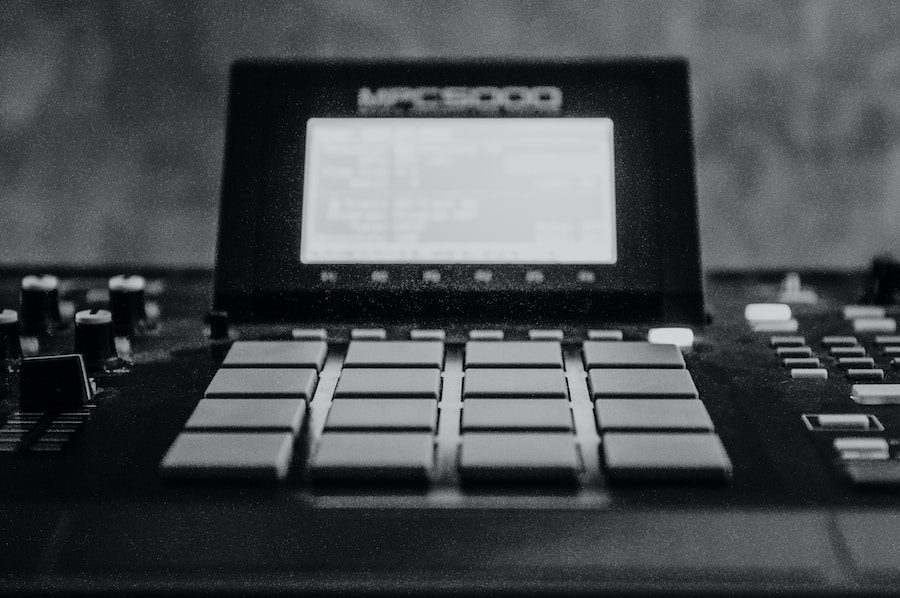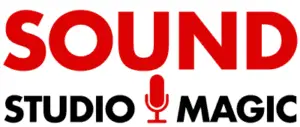Drum machines have been widely used in various music genres since the early 1980s, particularly in electronic, dance, and hip-hop music. Producers also use them in genres like EDM and techno music to create unique and innovative rhythmic patterns.
A drum machine is an electronic musical instrument designed to imitate the sound of drums, percussion, or other instruments. Drum machines typically provide percussion sounds, patterns, and sequencing capabilities that allow musicians to compose and arrange drum beats without needing a live drummer.
These devices come in various forms, including analog, digital, and software-based systems. Analog drum machines generate sounds through electronic circuits, while digital drum machines utilize samples, or pre-recorded drum sounds, which can be manipulated and sequenced. Software-based drum machines are programs or apps that run on a computer or mobile device, offering flexibility and integration with other digital audio workstations (DAWs).
Table of Contents
- History of Drum Machines
- Types of Drum Machines
- Features and Functions
- Popular Drum Machine Models
- Influence on Music Production and Genres
- How to Choose the Right Drum Machine

History of Drum Machines
Drum machines have played a significant role in the development of electronic music, providing artists with a convenient and efficient way to craft beats and rhythms.
They have enabled producers to experiment with different styles and layers of percussion, resulting in unique and innovative soundscapes. Although there has been debate regarding the authenticity and artistic merit of using drum machines compared to live drummers, these instruments have undoubtedly left an indelible mark on modern music production.
The history of drum machines can be broadly divided into three key periods: early drum machines, the digital revolution, and modern drum machines.
Early Drum Machines
Early drum machines emerged in the 1930s and 1940s as electro-mechanical instruments designed to imitate the sound of drums and other percussion instruments. One of the first commercial drum machines, the Rhythmicon, was developed by Russian inventor Léon Theremin in 1931. In the 1950s and 1960s, rhythm machines like the Wurlitzer Sideman and the Ace Tone FR-1 gained popularity among musicians, offering simple patterns for accompaniment.
Digital Revolution
The digital revolution in the late 1970s and 1980s saw the development of programmable drum machines, such as the Roland TR-808 and LinnDrum. These machines gave musicians greater control over their sound with the ability to create custom drum patterns and sounds. During this period, drum machines became a staple in genres like hip-hop, techno, and pop music.
- Roland TR-808 (1980): A classic and iconic drum machine known for its distinctive bass drum sound.
- LinnDrum (1982): The successor to the Linn LM-1, offering improved sound quality and more advanced sequencing capabilities.
- Roland TR-909 (1983): Known for its punchy snare and hi-hat sounds, popular in techno and house music.
Modern Drum Machines
Modern drum machines incorporate advanced technology, offering increased functionality and integration with digital audio workstations (DAWs). Software-based drum machines and mobile applications have gained popularity, allowing users to design their own drum sounds and patterns with greater flexibility. Hardware drum machines have also evolved, featuring touchscreens, integrated synthesizers, and comprehensive sound libraries.
| Drum Machine | Release Year | Notable Features |
|---|---|---|
| Ableton Live | 2001 | Software-based drum machine offering extensive sound design and sequencing capabilities. |
| Native Instruments Maschine | 2009 | Combines software and hardware elements for a seamless workflow and intuitive beat-making experience. |
| Roland TR-8S | 2018 | An updated version of the classic TR-808 and TR-909 drum machines, featuring modern sound design and DAW integration. |
Types of Drum Machines
Drum machines come in various forms, each offering unique sounds and functions to cater to different music genres and preferences. This section explores the three main types of drum machines: analog, digital, and hybrid.
Analog Drum Machines
Analog drum machines generate sound by creating electrical signals that pass through circuits to produce unique analog tones. These machines offer a warm, organic sound quality, popular among vintage and classic music enthusiasts.
- Notable features:
- Warm and authentic sound quality
- Classic design, often with physical knobs and buttons
- Less precise timing than digital drum machines
Digital Drum Machines
Digital drum machines rely on digital signal processing and sampling to produce sounds. They offer a wider range of capabilities and precise timing, making them ideal for modern music production.
- Notable features:
- Highly precise and quantized beats
- Extensive sound banks, often customizable
- Integrated MIDI compatibility and software options
Hybrid Drum Machines
Hybrid drum machines combine the best of both analog and digital technologies. They offer the warmth and character of analog machines while providing the precision and additional features found in digital counterparts.
- Notable features:
- A blend of analog and digital sound qualities
- Advanced sound design capabilities
- Offers a wide range of sound manipulation options
Features and Functions
A drum machine is an electronic musical instrument that can help musicians create drum patterns and beats. In this section, we will discuss the features and functions of a drum machine, especially focusing on sequencing and patterns, pads and triggers, and connectivity options.
Sequencing and Patterns
A drum machine allows users to program and customize different drum patterns using a sequencer. The sequencer is the heart of the drum machine, as it lets musicians create, store, and playback various patterns for composing songs or live performances.
Sequencers in drum machines can have different step resolutions (such as 16, 32, and 64 steps), which means the user can create more nuanced and intricate beat patterns. Some drum machines also support polyrhythms and the ability to chain several patterns together to make complex arrangements.
Pads and Triggers
Drum machines come with touch-sensitive pads or buttons for inputting drum sounds, adjusting parameters, or triggering sequences. Users can play different drum sounds, control dynamics, and even trigger effects or samples by striking these pads.
The responsiveness and feel of these pads can significantly impact the user experience. Some drum machines, such as the Roland TR-8S or Akai MPC, are well-known for their pad sensitivity, providing an authentic and expressive playing experience for the musician.
Connectivity
Modern drum machines often have various connectivity options, such as MIDI, USB, and audio outputs. These connections allow users to integrate the drum machine with other music production hardware and software, like DAWs, synthesizers, and effects processors.
MIDI connectivity enables users to control other MIDI-compatible devices using the drum machine. In contrast, USB connectivity provides a streamlined way to connect the drum machine to a computer for recording and sound editing. Audio outputs are essential for monitoring and performing live, allowing the user to connect the drum machine to an amplifier, PA system, or headphones.
Popular Drum Machine Models
Drum machines have evolved significantly since their inception, and today several popular models have shaped the world of music production. Let’s explore some of the most influential drum machines:
- Roland TR-808: This iconic drum machine was introduced in 1980, and although it was initially deemed a commercial failure, it gained popularity for its unique sounds and easy-to-use interface. It has been widely used in genres like hip-hop, electro, and dance.
- Roland TR-909: The TR-909, released in 1983, improved upon the TR-808 with more realistic drum sounds and a richer sound palette. Its solid bass drum and crispy snare became techno and house music staples. Like its predecessor, the 909’s sounds are still sought after today.
- Akai MPC60: Launched in the late 1980s, the Akai MPC60 was a game-changer, offering drum sounds, extensive sequencing, and sampling capabilities. Its responsive pads allowed for expressive playing, and it quickly became a cornerstone of beat-making in hip-hop and electronic music.
- Elektron Octatrack: A more recent addition to the drum machine pantheon, the Elektron Octatrack combines powerful sampling and sequencing with an 8-track audio recorder, enabling versatile loop manipulation and sound design. Among contemporary producers, it is highly valued for its flexibility and performance-oriented features.
Each drum machine has contributed to shaping modern music production, but it’s important to note that the list of popular models goes far beyond these examples. Music producers constantly seek new and innovative tools, so the realm of drum machines continues to evolve, offering fresh sounds and improved functionality for modern-day artists.
Influence on Music Production and Genres
A drum machine has significantly impacted various genres of music and music production techniques. The accessibility and versatility of these machines have given artists a new way to experiment with rhythms and sounds. This section will explore the influence of drum machines on Electronic Dance Music, Hip Hop, Experimental, and Ambient music.
Electronic Dance Music
Drum machines have played an essential role in shaping the characteristic beats and rhythms of Electronic Dance Music (EDM). Producers in this genre often rely on drum machines for their programmable, repetitive beats to create the desired high-energy atmosphere. Additionally, the ease of programming in drum machines allows EDM artists to layer and manipulate sounds to develop complex tracks.
Hip Hop
In Hip Hop, drum machines provide the foundation for most beats. Early Hip Hop artists largely adopted popular drum machines like the Roland TR-808 to create the iconic “boom bap” sound. These drum machines are crucial in creating the rhythmic structure of Hip Hop tracks, and their influence can still be heard in the genre today.
Experimental and Ambient
Experimental and ambient musicians have utilized drum machines to explore new sonic territories. In these genres, artists harness the capacity of these machines to create innovative rhythms, textures, and soundscapes. The programmability and flexibility of drum machines have allowed for unique fusions of electronic and organic elements, pushing the boundaries of musical experimentation.
Throughout these genres, the presence of drum machines in the creative process has shaped the course of modern music production. The impacts of their influence are heard distinctly in each genre’s beats, rhythms, and overall sound.
How to Choose the Right Drum Machine
When selecting the perfect drum machine, it’s important to consider several factors. These include the features, sound quality, ease of use, and price.
First and foremost, note the features the drum machine offers. This includes the number of built-in sounds, sequencing capabilities, and connectivity options. A few questions to ask yourself include:
- How many built-in sounds does the machine have, and are these sounds adjustable?
- Does the drum machine offer advanced sequencing and pattern creation?
- Can the machine be connected to external devices, such as a computer or other MIDI devices?
Next, pay attention to the sound quality of the drum machine. To determine whether the quality is satisfactory, listen to audio samples from various drum machines and compare them. Choose a drum machine with crisp, clear sounds that meet your musical expectations.
Ease of use is another critical aspect to consider. Some drum machines may be more challenging for beginners to navigate, while others offer a more user-friendly interface. Depending on your experience level, choose a drum machine that best suits your needs and allows you to explore the device’s full potential.
Lastly, consider the price of the drum machine. Drum machines can range from affordable to quite expensive. Determine your budget and ensure that you’re selecting a drum machine that balances cost and quality features essential to you.
- Review of the ALABS IRON MINI-WL: A Powerhouse Wireless Microphone - October 4, 2023
- What is a Saturator in Music Production: A Brief Explanation - May 11, 2023
- What Are Rotary DJ Mixers? An Overview - May 11, 2023
SoundStudiomagic.com is a participant in the Amazon Services LLC Associates Program, an affiliate advertising program designed to provide a means for sites to earn advertising fees by advertising and linking to Amazon.com. We also participate in other affiliate programs which compensate us for referring traffic.


